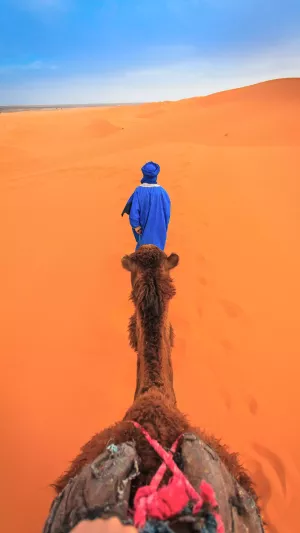The desert is a very unique landscape on earth, and the desert area has actually nurtured many civilizations. Desert areas are extremely scarce from water resources to food, so there are not many animals that can live in the desert, and camels are one of them.
In our impression, camels always play the role of porters in the desert. In fact, it is true that no animal is better at surviving in the desert than the camel, and their ears have hairs to prevent sand from being blown into their ears.
Camels have flat feet, so camels are less likely to sink into the sand than other animals.
The camel's fur is fluffy and thick, and the weather in the desert is particularly hot during the day and particularly cold at night. The camel's fur can withstand the direct sunlight during the day and keep out the cold at night, so it is very functional.
The camel's biggest advantage in the desert is its endurance. Because the camel can still walk without water in the desert, we humans will be very surprised, and at the same time, we will have a strong interest in the camel and want to know how it does it.
If you think about it, many people will focus on the camel's unique hump, and even think that the camel must store a lot of water in its hump, so there is no need to drink too much water when walking in the desert .
So what's in the camel's hump?
The part of the camel's back that bulges like a mountain is called the hump, and there are some differences in the number of humps of different types of camels, but there are only two cases, either a single hump or a double hump.
Whether it's a dromedary or a Bactrian camel, they store the same thing in their hump, which is fat. While many of us think of a camel's hump as its water bag, studies have shown that a camel's hump stores a lot of fat, not water. In fact, when we conjecture about the camel's hump, we should consider that if the hump is really a moving water bladder, how can we not hear a little sound when the water is swaying?
Moreover, when we ride on a camel, we can generally feel the texture of the hump at close range. The hump of a camel feels like a hard stone, and it does not have the texture of water in it at all. What is stored in the hump is the deposited fat, and the fat can only be oxidized to produce the metabolic water needed for the camel's life activities.
In addition, there are many small bubbles in the shape of bottles in the camel's stomach, which is where the camel stores water. The water in these "bottles" makes the camel's life not dangerous even if he does not drink water for a few days. When a camel loses 40% of its body weight, it will not have a big impact on its body. A camel can live for 7 days without drinking water, and it can drink up to 225 liters of water each time.
Therefore, we can know that the camel's hump does not play such a role as a solid water reservoir, but exists as a huge energy storage bank, and it provides the camel's material guarantee for energy consumption during the long-distance trek in the desert.
So, the camel's hump is not a water reservoir. Moreover, the camel's ability to walk in the desert under anhydrous conditions for so long is not only due to the hump, but also requires the cooperation of other functions in the camel's body.





